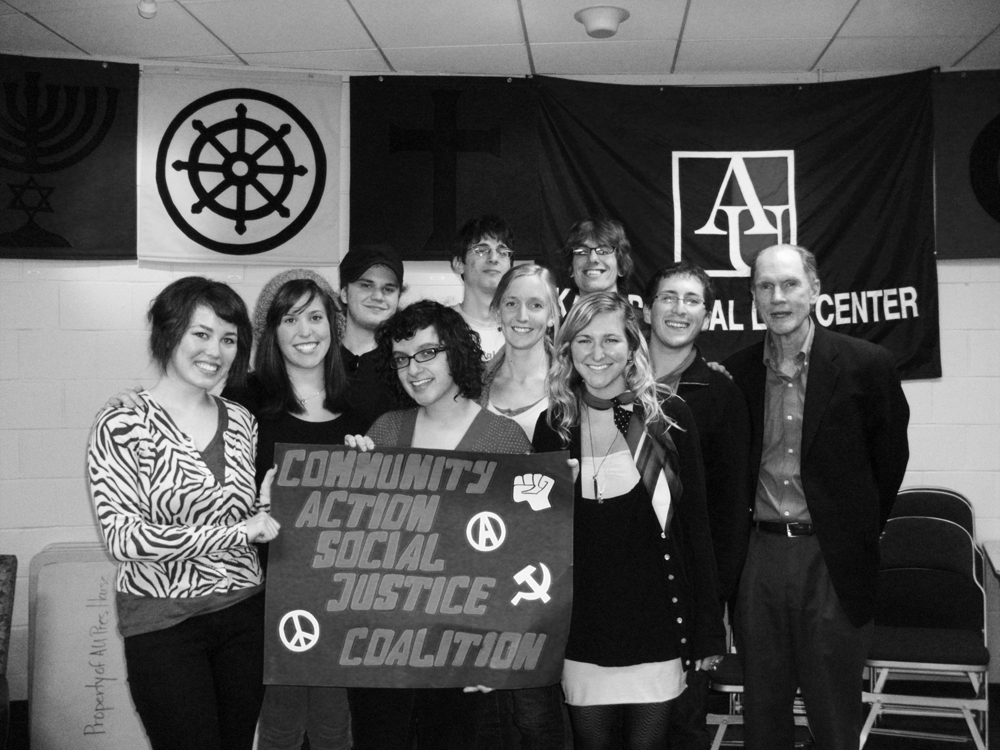Explained: What is CASJ again?
CASJ has existed in many configurations since the ’60s, when it was established by the University Chaplain to counsel those drafted for the Vietnam War. Rumor has it that the office was so successful that it was investigated by the FBI for encouraging draft-dodging. In the early 2000s, CASJ broke from its affiliation with the Chaplain and merged with other groups on campus to create a more inclusive coalition of student activists. Since then, the CASJ office has existed as an organizing space for AU students and the D.C. community.
The central organizing body of CASJ is the CASJ collective, a group of volunteers (each of whom are usually involved in a coalition club) tasked with administrative duties. These duties include hosting monthly town hall meetings for the campus community to discuss local issues, bringing radical speakers to campus, sending out weekly emails about upcoming events at AU and in D.C., and being present in the CASJ office for at least five hours per week. In addition to these regular duties, CASJ collective members organize campus-wide campaigns. Over the past two years, CASJ has become increasingly active, launching campaigns to reform the Judicial Affairs and Mediation Services office (now Student Conduct and Conflict Resolution Services), secure better benefits for our shuttle drivers and Aramark service workers, and persuade AU to formally commit its vendors to fair trade coffee. All of these campaigns have taken hours of petitioning, mass emailing and sign-making by the volunteer collective.
One measure of CASJ’s progress is this year’s surge in membership. Recently it hosted members of the Beehive Design Collective, an artist group dedicated to resisting corporate globalization. Despite the small size of the room in McKinley Hall where the event was held, it was attended by more than two dozen people. After the meeting, former CASJ collective member and AU senior Mary Schellentrager expressed excitement at the turnout. “The activist community’s grown,” she said. Schellentrager believes the group has become not only more inclusive, but more effective as well. “[Before] only a couple of the collective members were active in the community, but now the collective’s made up of people who are more involved in the [coalition] clubs.”
Off campus, the group is also dedicated to being a hub of student activism. CASJ helped organize the recent Funk the War demonstration, a “militant mobile dance party” in which 500 students mobbed the K Street area on March 19. At the protest, students temporarily occupied the front of the U.S. Treasury Building, with two individuals scaling one of its pillars and unfurling a banner that read “End the Wars, Fund our Future.” More recently, CASJ met with other student groups from Howard University, University of Maryland, George Washington University and Georgetown University to discuss the establishment of a progressive student union in the D.C. area. While still in the planning stages, the proposed “Radical Student Network” would facilitate cross-campus projects so that D.C. area student activists could coordinate campaigns together.
Despite its increased activity, CASJ is still in the growing process. Although it has worked to co-sponsor events with historically marginalized identity-based groups such as the Black Student Alliance and the Latin American Student Organization, the coalition itself sorely lacks adequate representation from such groups. The same is true for CASJ’s relationship with the sizeable LGBT community at this school. Even though AU prides itself on its “diversity and inclusion” (according to the Multicultural Affairs Web site), most students can attest to campus-wide racism, sexism, and homophobia. To address these issues, the group hopes to do more campaign work with the Multicultural Advocacy and LGBT Resource centers in the future. So while CASJ has improved, there is still much work to be done before it can be considered a truly comprehensive social justice coalition at AU.
Ultimately, CASJ is a powerful resource for those interested in working for social change. “CASJ is the vehicle through which people get involved in social and economic justice work at AU,” said CASJ collective member Drew Franklin. “It helped me accomplish what I came to DC to do in the first place: develop my skills as an organizer. A lot of other clubs on campus talk about issues in terms of policy changes and party politics. CASJ’s the only group that focuses on the grassroots, at the community level,” he said. “In the end, that’s the only level that really matters.”







